The idea of Filipino liveliness comes from the country’s rich culture and history. It shows the lively spirit and energy of the Filipino people. This spirit is what makes the Filipino people unique and strong, affecting their daily lives and the world around them.
The Filipino culture values community, resilience, and joy. These values shine through in their traditions, values, and arts.
The Filipino liveliness shows the country’s ability to overcome obstacles. It embodies the lively spirit of the Filipino people. The Maglalatik dance is a symbol of fertility and abundance, celebrating the harvest season and fertility in Philippine culture.
Key Takeaways
- The Filipino culture is known for its vibrant energy and spirit, which is reflected in its rich cultural heritage and history.
- The concept of Filipino liveliness is deeply rooted in the country’s traditions, values, and arts.
- The Maglalatik dance is a symbol of unity and celebration of the harvest season and fertility in Philippine culture.
- Filipino liveliness is a testament to the country’s ability to thrive and flourish despite challenges.
- The Filipino spirit is unique and resilient, and has a significant impact on the daily lives of Filipinos and the global community.
- The preservation of traditional dances like Maglalatik is important in keeping cultural heritage alive for future generations.
The Essence of Filipino Culture
Filipino culture is a rich mix of historical roots and traditions. The country’s unique identity comes from over 300 years of Spanish rule. This is seen in its values and customs. For example, the Maglalatik dance shows the country’s farming heritage and cultural richness.
The culture values community and family deeply. Its history has shaped its traditions and cultural ways. Key aspects of Filipino culture include:
- Respect for elders and authority
- Strong family ties and close-knit communities
- Love of music, dance, and celebrations
- Rich cultural heritage and traditions
In conclusion, Filipino culture is vibrant and dynamic. It combines historical roots, traditions, and values. Understanding and valuing these aspects can foster cross-cultural awareness and exchange.
| Aspect of Filipino Culture | Description |
|---|---|
| Historical Roots | Over 300 years of Spanish colonization and influence |
| Traditions | Rich cultural heritage and customs, such as the Maglalatik dance |
| Values | Strong sense of community and family, respect for elders and authority |
Liveliness in Filipino Festivals
Filipino festivals show the country’s liveliness and love for celebrations. With thousands of festivals every year, the Philippines knows how to celebrate. Colorful parols, traditional lanterns, street dancing, and music make these festivals unforgettable.
The Philippines has a rich history of celebrations and festivities, dating back to the Spanish colonial period. Today, these festivals are key in Filipino culture. They bring people together, fostering community and liveliness.
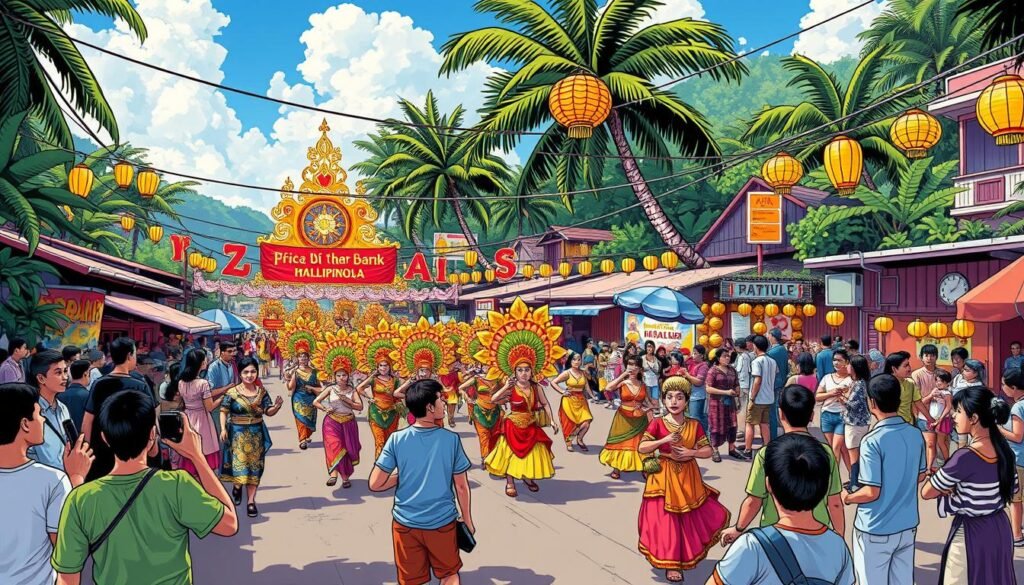
Major Festivals Celebrated in the Philippines
- Sinulog Festival: a colorful festival held in Cebu to honor the Santo Niño
- Ati-Atihan Festival: a festival held in Kalibo to commemorate the arrival of Malay datus
- MassKara Festival: a festival held in Bacolod to promote smiles and happiness
Unique Local Celebrations
The Philippines also has many unique local celebrations. For example, Tarlac town shines during Christmas with parols and lanterns. Tarlac is also famous for Belenismo, using recycled materials for nativity scenes.
The Role of Music in Filipino Liveliness
Music is a big part of Filipino culture. Traditional genres like Kundiman and Rondalla are key parts of our heritage. These genres have been passed down for generations and are celebrated today.
Recently, modern influence has changed the Filipino music scene. Many artists mix traditional and modern styles. This mix has created a unique sound that is distinctly Filipino. Filipino music is now popular all over the world. Artists like Darren Espanto and the Filipino Superwoman Band are known globally.
Some notable examples of Filipino music include:
- Kundiman: a traditional Filipino love song
- Rondalla: a traditional Filipino string band
- OPM (Original Pilipino Music): a genre that encompasses a wide range of Filipino music styles
The impact of Filipino music on the global music scene is huge. Many international artists are inspired by traditional Filipino genres. The mix of traditional genres and modern influence has created a sound that draws in audiences worldwide.
| Artist | Genre | Notable Works |
|---|---|---|
| Darren Espanto | OPM | Darren, Be with Me |
| Filipino Superwoman Band | OPM | Superwoman: Empire of Care |
Filipino Cuisine: A Feast for the Senses
Filipino cuisine is a vibrant mix of the country’s culture. It has signature dishes that show the lively spirit and community bond. Dishes like Sinigang with its tangy tamarind broth and Adobo with its rich flavors offer a variety of tastes and textures.
The regional cuisines of the Philippines also shape the country’s food identity. Each region has its own dishes and specialties. For instance, the north is known for bold flavors and spices, while the south uses fresh seafood and coconut milk.
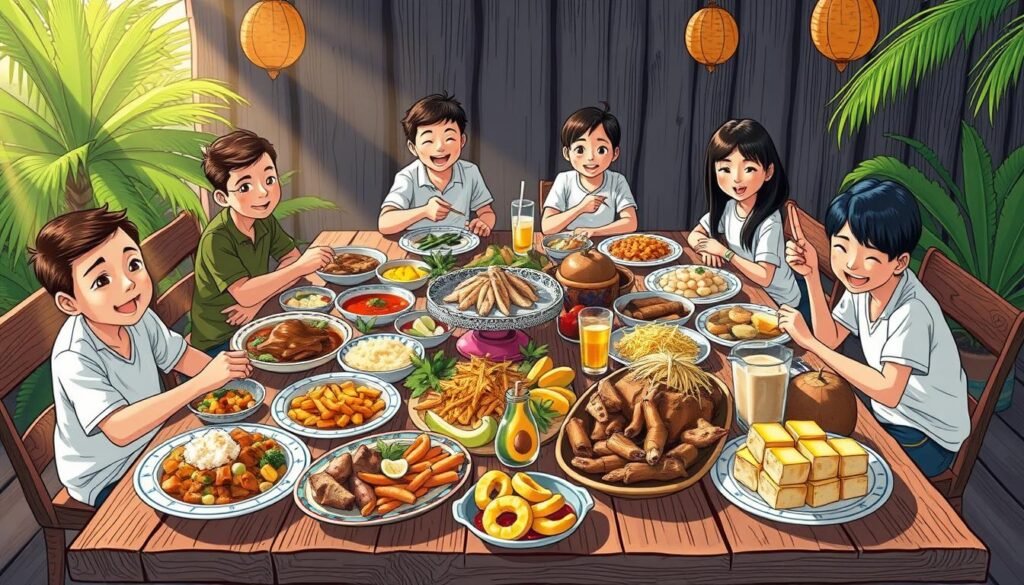
Popular signature dishes include Lechón, a whole roasted pig, and Kare-Kare, a peanut sauce stew. These dishes are not just tasty but also tell the country’s cultural and historical stories. Filipino cuisine is a feast for the senses, with its unique flavors and ingredients.
Trying regional cuisines or signature dishes, Filipino food has something for every food lover. With its rich flavors, vibrant culture, and warm hospitality, the Philippines is a culinary destination that delights and inspires.
Language and Expression
Filipino languages are full of vibrancy and can express deep emotions. They use humor and wit to connect with others. For example, words like “Pak!,” “Lodi,” “Kilig,” “Petmalu,” and “Awit” add fun to chats.
Colloquialisms make conversations more real and exciting. Knowing words like “Jusko,” “Aruy,” “Awit,” and “Edi wow” makes talks richer. To learn more about Baybayin, visit this website.
Switching between English and Tagalog, or Taglish, is common in the Philippines. It shows the mix of languages and cultures. Taglish makes stories and memories come alive.
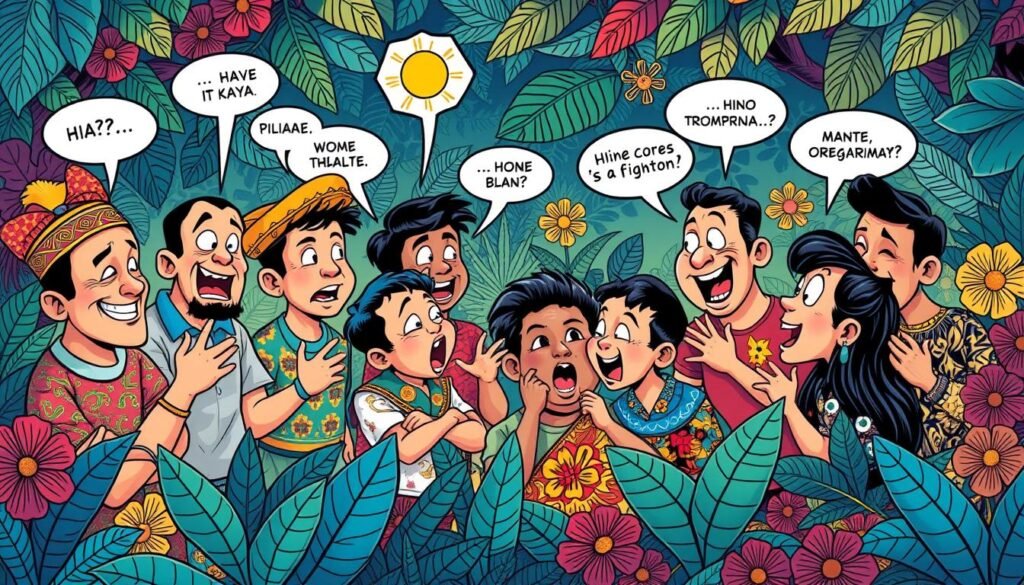
The Vibrancy of Filipino Languages
Some key traits of Filipino languages include:
- Colloquialisms and slang add flavor to talks
- Code-switching shows cultural identity
- Humor and wit connect people and share feelings
The Power of Humor and Wit
Humor and wit are big in Filipino culture. They help people connect and share feelings in a fun way. Understanding Filipino languages lets us see the culture and values of the Filipino people.
The Filipino Spirit in Arts and Crafts
Filipino arts and crafts are a big part of the country’s culture. The industry has grown a lot. Many new artists are helping it grow.
Rita Nazareno and Gabby Lichauco have worked with local brands. They show off the best of Filipino arts and crafts.
Traditional crafts, like those from Tadeco Home and S.C. Vizcarra, show the country’s deep culture. Tadeco Home uses materials from its own farm and works with local artists. This makes each piece special and of high quality. S.C. Vizcarra has been making handwoven bags and accessories for 97 years. This shows how loved traditional crafts are.
Today, new artists are changing the game. Nature’s Legacy uses special techniques to make home decor from natural and recycled materials. This shows the creativity of Filipino artists. The CCP Encyclopedia of Philippine Art also shows the country’s rich culture.
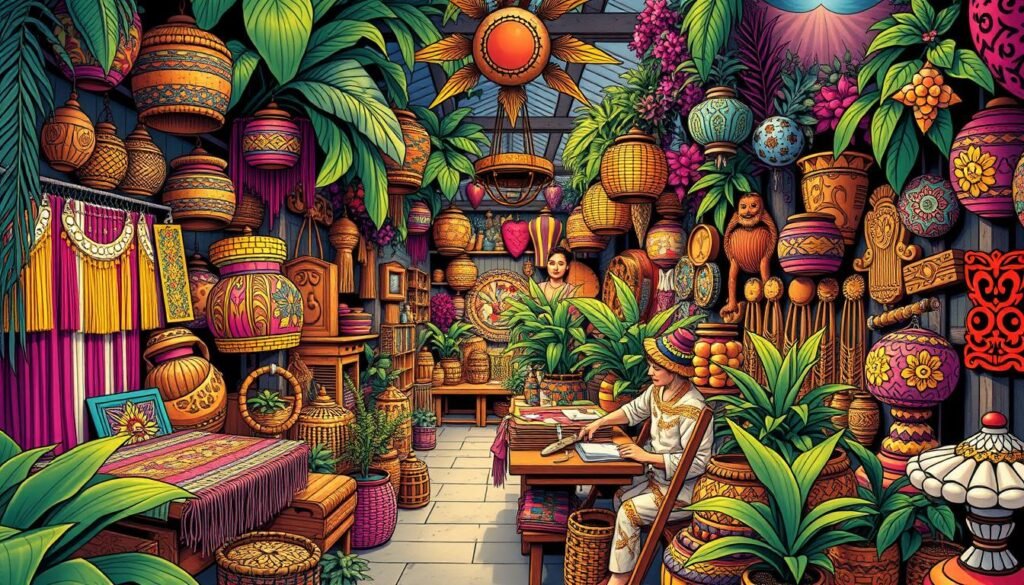
The industry has grown a lot. More writers and texts have appeared in the local publishing scene. Literary theory and criticism have led to new ways of seeing literature and reading. This shows a lot of academic interest in the field.
The variety of Filipino arts and crafts is clear. Different literary forms and modes are produced in languages like Tagalog, Cebuano, and Ilocano. This diversity is a big part of the country’s culture.
| Category | Description |
|---|---|
| Traditional Crafts | Reflect the country’s rich cultural roots, such as Tadeco Home and S.C. Vizcarra |
| Contemporary Artists | Contribute to the industry’s growth, using innovative techniques and materials, such as Nature’s Legacy |
| Literary Forms | Cover various modes produced in different Philippine languages, including Tagalog, Cebuano, and Ilocano |
Filipinos and their Resilience
Filipino resilience shows the country’s strength in facing challenges with hope. Despite many obstacles, like natural disasters and economic hard times, Filipinos keep moving forward. This strength comes from their tight-knit communities.
Family and community bonds are key to Filipino resilience. When times get tough, Filipinos help each other out. This support is vital for dealing with hard times. Optimism also plays a big role, keeping people positive even when things seem bleak.
Here are some examples of Filipino resilience:
- Surviving natural disasters, such as typhoons and earthquakes, with minimal resources
- Overcoming economic challenges, such as poverty and unemployment
- Thriving in the face of social and political instability
These examples show how strong and resilient Filipinos are. They highlight the role of community support and optimism in facing challenges. By holding onto these values, Filipinos build a resilient community that can handle tough times.
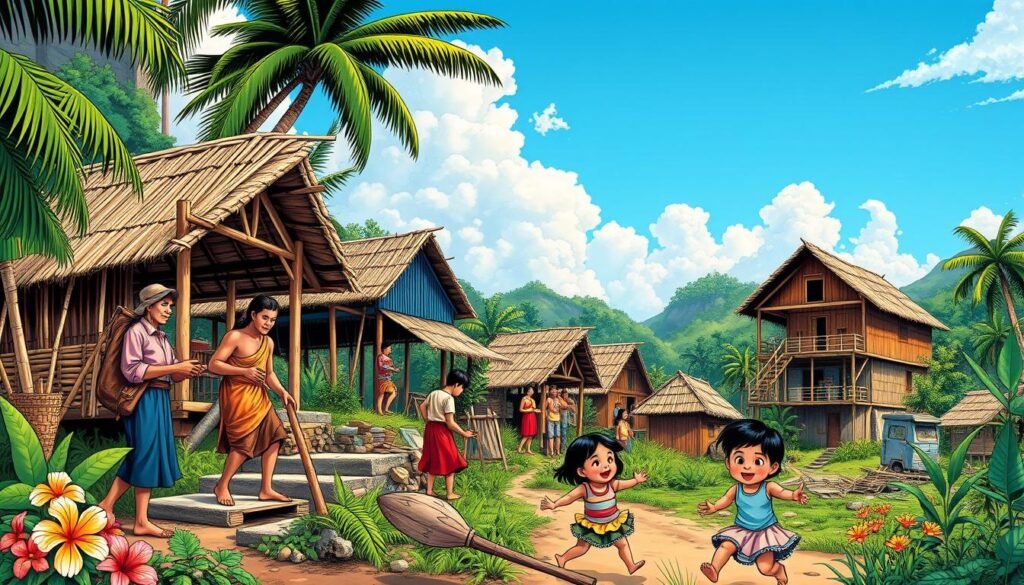
In conclusion, Filipino resilience is a powerful force. It helps people face challenges with hope and support from their community. Understanding and embracing this resilience can help us build stronger, more supportive communities.
| Category | Example | Impact |
|---|---|---|
| Natural Disasters | Typhoons, earthquakes | Community support and optimism enable Filipinos to survive and recover |
| Economic Challenges | Poverty, unemployment | Filipino resilience helps individuals cope with economic hardship and find opportunities for growth |
| Social and Political Instability | Protests, political upheaval | Filipino community support and optimism promote social cohesion and stability |
Sports and Filipino Liveliness
Filipino sports unite communities and raise cultural awareness. The country’s sporting culture is rich and vibrant. Filipino athletes have won international fame, bringing pride to the nation.
Popular Sports that Energize the Nation
Basketball, boxing, and volleyball are top sports in the Philippines. Many Filipinos play these sports at local and national levels. The country boasts athletes like June Mar Fajardo in basketball and Manny Pacquiao in boxing.
Celebrating Filipino Athletes
Filipino athletes are celebrated for their achievements. Their success brings national pride. The Philippines supports its athletes, cheering them on globally.
The government sees sports as key to unity and development. It provides support and resources to athletes and sports programs.
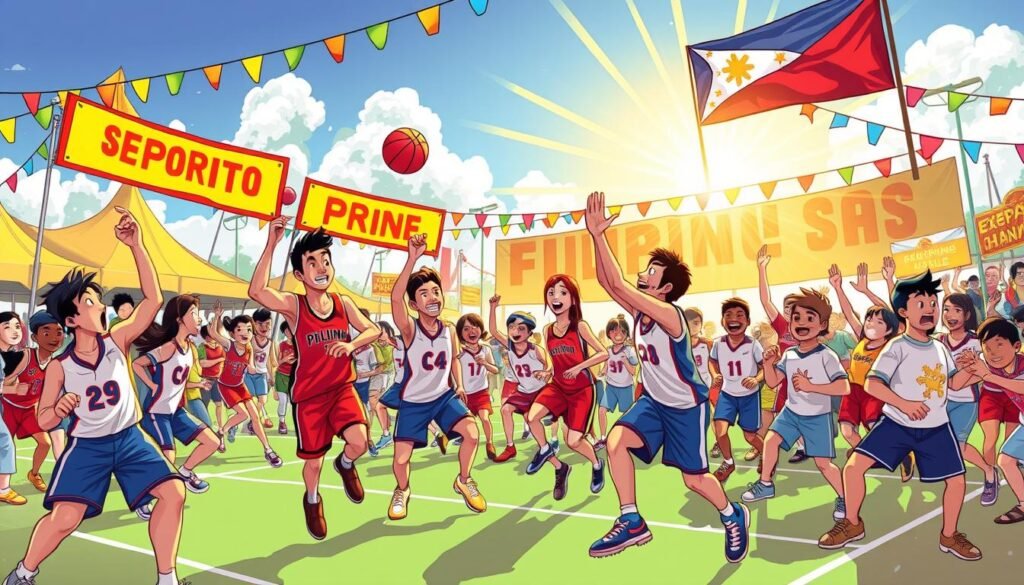
Filipino athletes are celebrated beyond their sports achievements. They promote Filipino culture and values. They are seen as ambassadors, showing the world the best of Filipino sports and culture.
| Popular Sports | Famous Filipino Athletes |
|---|---|
| Basketball | June Mar Fajardo |
| Boxing | Manny Pacquiao |
| Volleyball | Alyssa Valdez |
The Role of Family in Filipino Society
The Filipino family is a key part of the country’s social structure. They have strong bonds and values that last for generations. Family is more than just a group in the Philippines; it’s a source of identity, support, and strength.
Family ties in the Philippines are very close. Many family members live together or near each other. This closeness is a big part of their culture.
Family values like respect, loyalty, and hospitality are very important in the Philippines. Filipino families also have a strong sense of community. They often take part in community activities and events.
The Filipino family is essential to the country’s social and economic growth. Their strong bonds and values help the country thrive.
Some key traits of the Filipino family include:
- Close-knit ties among family members
- Strong sense of respect and loyalty
- Importance of community and social relationships
- Priority on family values such as hospitality and respect for elders
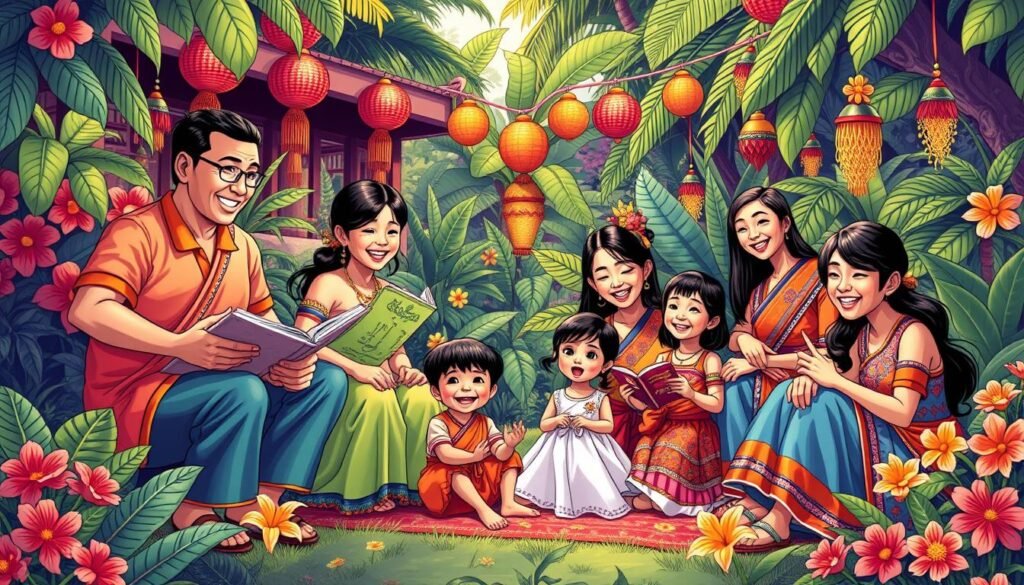
In conclusion, the Filipino family is vital to the country’s growth. Their strong bonds and values are key to the country’s prosperity.
| Characteristics | Importance |
|---|---|
| Close-knit ties | Vital for social support and identity |
| Strong sense of respect and loyalty | Essential for family harmony and social cohesion |
| Importance of community and social relationships | Crucial for social and economic development |
Joyful Filipino Celebrations at Home
Filipino celebrations are full of energy and hospitality. People gather to share food, drinks, and stories. This creates a warm and welcoming atmosphere. The New Year’s Eve celebration is a big one, where families and friends welcome the new year with hope.
These gatherings are more than just fun. They’re about hospitality and building community. Filipinos make sure their guests feel at home. They offer delicious food and lively music to make the celebration unforgettable.
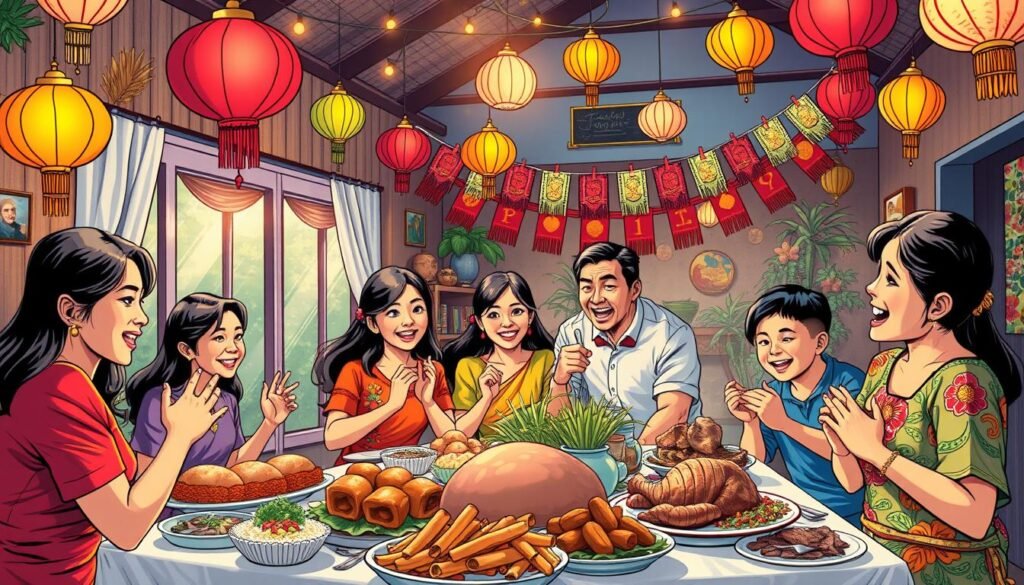
Festive gatherings are key in Filipino celebrations. They help unite the community and celebrate culture. Whether it’s a birthday, wedding, or holiday, Filipinos make every event joyful and memorable. They show their famous hospitality and love for Filipino celebrations.
The Significance of Bayanihan
The idea of Bayanihan is all about community and unity. It’s a way of life in the Philippines where people help each other. They work together to reach their goals.
“Bayanihan” by Fernando Amorsolo shows this idea. It’s a painting of villagers moving a nipa hut together. It shows the value of teamwork and community support in Filipino culture.
Some key parts of Bayanihan are:
- Community unity and cooperation
- Shared responsibility and teamwork
- Resilience and adaptability in the face of challenges
The Filipino spirit of community is shown in Bayanihan. It’s a big part of Philippine culture. It shows the country’s rich heritage and people’s ability to unite in hard times.

By understanding Bayanihan, we can build a stronger community. This leads to a more united and resilient society.
| Aspect | Description |
|---|---|
| Community Unity | People working together towards a common goal |
| Shared Responsibility | Shared tasks and responsibilities among community members |
| Resilience | Ability to adapt and overcome challenges as a community |
Filipino Humor: The Lighthearted Spirit
Filipino humor is a special part of our culture. It brings people together and creates a sense of community. Comedy is big in our daily lives, helping us deal with tough times. The Philippines is home to many talented comedians who have made a big impact in entertainment.
Some Filipino comedians are famous not just in the Philippines but worldwide. For example, famous Filipino comedians have starred in TV shows and movies. They show off their talent and quick thinking. Humor is everywhere in our culture, not just in shows.
Humor is important because it unites us. It helps us face challenges together. As seen in the story of Emiliano Riego de Dios, it gives us hope and strength.
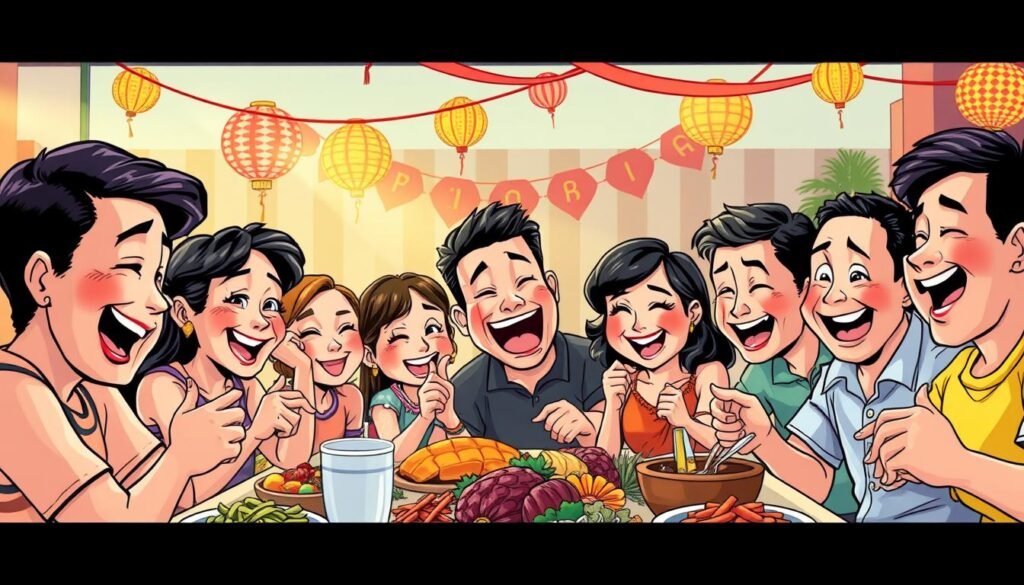
The Role of Comedy in Daily Life
Comedy is a big part of our daily lives. Many Filipinos use humor to handle tough times. It’s not just for shows; it’s in our everyday talks and interactions too.
Famous Filipino Comedians
Some famous Filipino comedians include:
- Dolphy
- Chiquito
- Pocholo Gonzales
These comedians have greatly contributed to entertainment. They help spread Filipino humor and culture.
Nature and Liveliness in the Philippines
The Philippines is famous for its stunning Filipino nature. It boasts scenic landscapes that fill people with joy and wonder. The country’s natural beauty offers many eco-tourism chances.
Some top scenic landscapes include the Chocolate Hills, the Mayon Volcano, and the Underground River. These spots draw millions of visitors yearly. They highlight the country’s rich Filipino nature and support eco-tourism.
To boost eco-tourism in the Philippines, the government has started several projects. These include:
- Creating national parks and protected areas
- Creating sustainable tourism plans
- Helping local communities in conservation
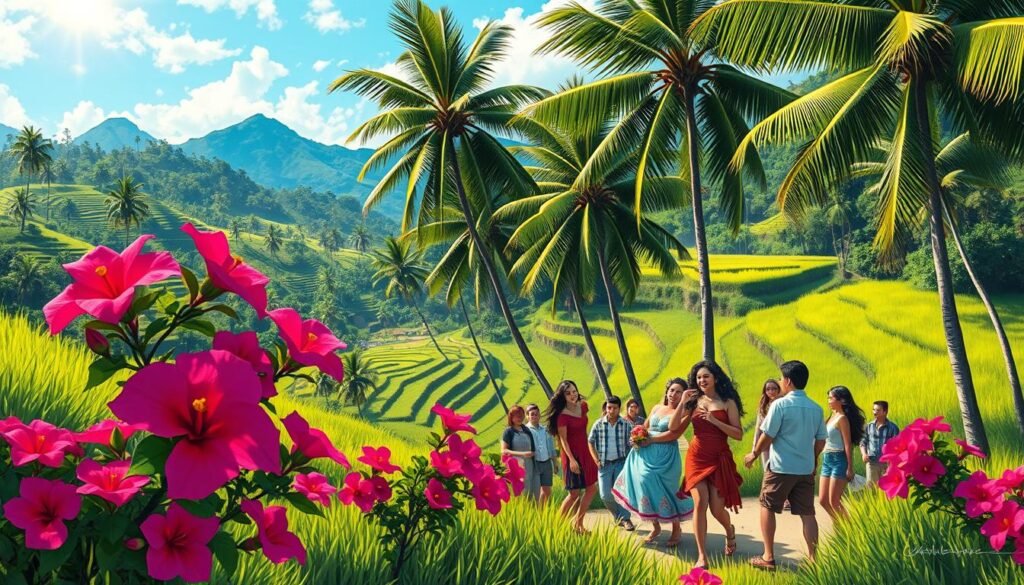
By focusing on eco-tourism and keeping the scenic landscapes safe, the Philippines can show off its unique Filipino nature. This helps the country’s economy grow and develop.
| Location | Description |
|---|---|
| Chocolate Hills | A geological formation of over 1,000 conical hills |
| Mayon Volcano | A active volcano known for its perfect cone shape |
| Underground River | A UNESCO World Heritage Site and one of the world’s most beautiful rivers |
Filipino Contributions to Global Culture
Filipino contributions have greatly influenced global culture. The Philippines combines Asian and Western influences in a unique way. This blend is seen in art, music, and literature. Famous Filipinos, like Nicomedes Joaquin, have made big impacts on the world’s culture.
Some key examples of Filipino contributions include:
- The Santo Niño celebration, a big part of Filipino culture and identity.
- Works by Filipino writers and journalists, like Nicomedes Joaquin, recognized worldwide.
- The Filipino community’s strong presence in countries like Japan, enriching local culture.
The Filipino spirit of community and resilience is known worldwide. Many countries value the contributions of Filipino migrants. This shows how Filipino culture is a vital part of global culture, promoting understanding and appreciation.
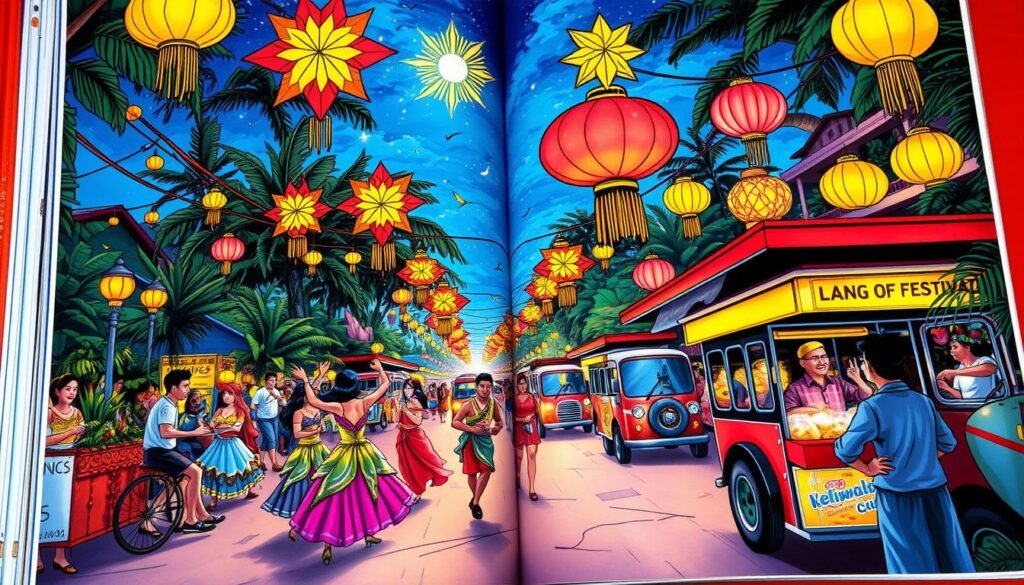
Filipino contributions have made global culture richer. Their influence will be felt for many years. By sharing their culture and promoting awareness, Filipinos have made a lasting impact on the world.
| Filipino Contribution | Global Impact |
|---|---|
| Celebration of the Santo Niño | Promoting cultural awareness and appreciation |
| Works of Filipino writers and journalists | Contributing to global literature and journalism |
| Filipino community’s presence in other countries | Establishing a significant ecclesial presence and contributing to local culture |
Education and the Future of Filipino Liveliness
Filipino education is vital for culture and youth engagement. The Philippines has a rich culture, and education helps keep it alive for future generations. Paulo Joquino says education shapes young Filipinos and prepares them for tomorrow.
To boost culture and youth engagement, schools can add special activities to their lessons. These might include:
- Cultural festivals and events
- Traditional music and dance performances
- Language classes that focus on Filipino dialects
- Community service projects that promote social awareness and involvement
These activities help schools promote culture and engage youth. This shapes young Filipinos and prepares them for the future. As Filipino education grows, keeping culture and youth engagement alive is key.
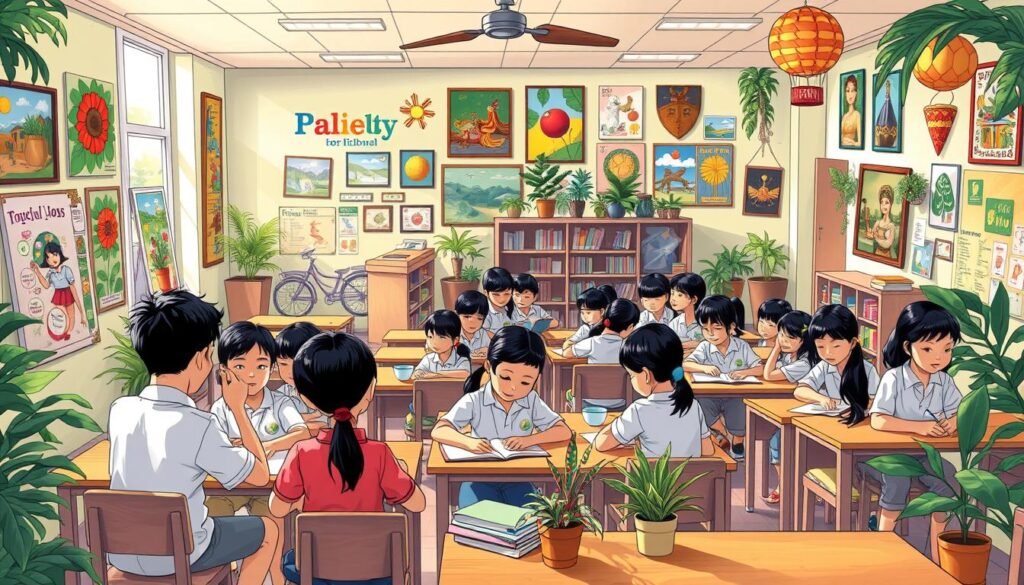
By focusing on these areas, we ensure the next generation is ready for the world. They will have the knowledge, skills, and values needed to succeed. This is done through a balanced education that includes culture and youth engagement activities.
| Activity | Objective |
|---|---|
| Cultural festivals and events | Promote Filipino culture and encourage youth engagement |
| Traditional music and dance performances | Preserve and promote Filipino cultural heritage |
| Language classes | Focus on Filipino dialects and promote language preservation |
Conclusion: Celebrating Filipino Liveliness
As we wrap up our look at the Filipino spirit, it’s clear that the rich cultural heritage of the Philippines is a source of pride and joy. The nation’s lively festivals and inspiring stories of resilience show the Filipino people’s passion for their diverse roots.
The heart of Filipino liveliness is in celebrating life’s joys and facing challenges with a positive mindset. By teaching these values to future generations, we ensure the Filipino spirit keeps thriving. Let’s all embrace the cultural diversity that makes the Philippines unique and vibrant.
FAQ
What is the essence of Filipino culture?
Filipino culture is shaped by history, traditions, and values. It shows the impact of Spanish rule and the keeping of old traditions. Traditional dances like the Maglalatik help spread cultural awareness.
What are the major festivals celebrated in the Philippines?
The Philippines has many lively festivals. These include big celebrations and local events. They help unite communities and raise cultural awareness.
How does music contribute to Filipino liveliness?
Music is a big part of Filipino culture. Traditional and modern music both have a big role. Traditional music keeps cultural values alive, while modern music reaches the world.
What are the signature dishes that embody the liveliness of Filipino cuisine?
Filipino food is full of flavor and life. Dishes like adobo and sinigang show the culture’s vibrancy. Regional foods add to the diversity of Filipino cuisine.
How do Filipino languages and humor contribute to the country’s cultural identity?
Filipino languages and humor add to the country’s spirit. They help unite communities and spread cultural awareness.
How do Filipino arts and crafts reflect the country’s cultural heritage?
Traditional crafts and modern art show the Philippines’ rich heritage. These arts help people appreciate and understand Filipino culture.
What role does the Filipino spirit of community, known as Bayanihan, play in the culture?
Bayanihan is about community and helping each other. It’s important in Filipino life. It helps build strong communities.
How do Filipino sports and athletes contribute to the country’s liveliness?
Sports like basketball and boxing energize Filipinos. Celebrating athletes also shows the country’s lively culture. These activities bring people together.
What is the significance of family in Filipino society?
Family is very important in the Philippines. Strong family bonds and values shape the culture. Family is at the heart of Filipino life.
How do Filipinos celebrate joyful occasions at home?
Filipinos love to celebrate at home. They have big gatherings and events. These celebrations are key to Filipino culture and community.
What is the significance of Filipino humor and the lighthearted spirit?
Humor and a light spirit are big in Filipino culture. Comedy is a big part of daily life. Famous comedians show the power of humor in bringing people together.
How do the natural landscapes and eco-tourism of the Philippines contribute to its liveliness?
The Philippines’ natural beauty inspires joy and wonder. Eco-tourism lets visitors experience the culture. These wonders are key to the country’s liveliness.
How have Filipinos made contributions to global culture?
Filipinos have shared their culture with the world. They show their talents and contribute to global awareness. Famous Filipinos have helped spread appreciation for their culture.
What is the role of education in preserving and promoting Filipino liveliness?
Education is key to keeping Filipino culture alive. It teaches young people to appreciate their culture. Getting youth involved in culture is important for the future.
Source Links
- Maglalatik dance in Philippines: Origin, History, Costumes, Style | DanceUs.org – https://www.danceus.org/style/maglalatik-dance-in-philippines/
- PDF – https://www.postcolonial.org/index.php/pct/article/viewFile/1803/1758
- PDF – https://jayna.usfca.edu/asia-pacific-perspectives/pdfs/v6n1_delrosario_gonzalez.pdf
- Call Center Culture in the Philippines | SupportZebra – https://supportzebra.com/blog/from-sunset-to-sunrise-the-pulse-of-call-center-culture-in-the-philippines-support-zebra
- What We Can Learn from Filipino Christmas Traditions – Pacific Ties – https://pacificties.org/what-we-can-learn-from-filipino-christmas-traditions/
- Beyond Desks and Chairs: What Makes a Filipino Office Culture? | HGS OSS – https://hgsoss.com/newsroom/beyond-desks-and-chairs-what-makes-a-filipino-office-culture/
- Project MUSE – Feeling in Counterpoint: Complicit Spectatorship and the Filipino Performing Body – https://muse.jhu.edu/article/706610
- Performing Liveness | JFMO Suki – https://suki.jfmo.org.ph/features/performing-liveness/
- Wine Pairing with Filipino Food: Match Made! – https://gigglygrapes.com/wine-pairing-with-filipino-food/
- PDF – https://consortiacademia.org/wp-content/uploads/2023/v13i16/24832_final.pdf
- Celebrate Diversity: Festivals in The Philippines – https://pinaywise.com/philippines-facts/celebrate-diversity-festivals-in-the-philippines/?srsltid=AfmBOooDKQ8cAOPOOrTMdfq_hvRhKga1D3V8KqR-vmC9Ed5uS5A3R6YP
- 23 Tagalog Colloquialisms to Add Personality to Your Conversational Tagalog – https://fluentfilipino.com/23-tagalog-colloquialisms-to-add-personality-to-your-conversational-tagalog/
- PDF – https://jps.library.utoronto.ca/index.php/elhdc/article/view/20792/17029
- Liveness as Livelihood – https://www.goethe.de/prj/nus/en/mag/lvn.html
- Celebrating Filipino in Any Kind of Place – https://fameplus.com/touchpoint/celebrating-filipino-in-any-kind-of-place
- CCP Encyclopedia of Philippine Art | CCP Encylopedia of Philippine Art – https://epa.culturalcenter.gov.ph/project_intro_to_sections/
- PDF – https://repository.usfca.edu/cgi/viewcontent.cgi?article=1008&context=asiapacificperspectives
- Finding strength in solitude POINT OF VIEW – https://www.philstar.com/the-freeman/opinion/2024/10/27/2395488/finding-strength-solitude-point-view
- Influence of Sports Engagement to the Development of Life Skills of Students – International Journal of Research and Innovation in Social Science – https://rsisinternational.org/journals/ijriss/articles/influence-of-sports-engagement-to-the-development-of-life-skills-of-students/
- Stories, Songs, Crafts and Games for Kids : Jimenez, Gidget Roceles, Dandan-Albano, Corazon: Amazon.co.za: Books – https://www.amazon.co.za/All-About-Philippines-Stories-Crafts/dp/0804848483
- Feeling in Counterpoint: Complicit Spectatorship and the Filipino Performing Body – https://muse.jhu.edu/article/706610/pdf
- Feeling in Counterpoint: Complicit Spectatorship and the Filipino Performing Body – https://muse.jhu.edu/pub/1/article/706610/pdf
- Pasko Menu: Brewing Filipino Christmas Traditions at Coffee Sarap — Coffee Sarap – https://www.coffeesarap.com/blogs/pasko-menu-brewing-filipino-christmas-traditions-at-coffee-sarap
- How to Use Color Psychology to Enhance Your Mood at Home – BluPrint – https://bluprint-onemega.com/myhome/trends/color-psychology-to-enhance-your-mood/
- Sinulog Savors: Exploring the Flavorful Traditions of the Pit Senyor Festival — Pinoy Kitchen – https://www.pinoykitchen.eu/blog/sinulog-savors-exploring-the-flavorful-traditions-of-the-pit-senyor-festival
- Answers to: Write an essay about I learned about paintings of Fernando Amorsolo Bayanihan – https://www.classace.io/answers/write-an-essay-about-i-learned-about-paintings-of-fernando-amorsolo-bayanihan
- ART APPRECIATION – https://www.slideshare.net/slideshow/art-appreciation-228316326/228316326
- colonialism – THE PHILIPPINES MATRIX PROJECT – https://philcsc.wordpress.com/tag/colonialism/
- PDF – https://lirias.kuleuven.be/bitstream/123456789/506723/1/PhD Dissertation – Jeremiah A. Reyes.pdf
- 100 Most Influential Filipino Women on LinkedIn 2022 – https://www.connectedwomen.co/magazine/100-most-influential-filipino-women-on-linkedin-2022/
- Filipino Characteristics – https://www.visitphilippines.org/about-philippines/culture/filipino-characteristics/
- Living in a Third-Culture – https://giannaburgos.medium.com/living-in-a-third-culture-aff30d90c368
- On the Personhood of Sacred Objects: Agency, Materiality and Popular Devotion in the Roman Catholic Philippines – https://www.mdpi.com/2077-1444/12/7/454
- Nick Joaquin – https://en.wikipedia.org/wiki/Nick_Joaquin
- Exploring Marginality among Filipino Catholics in Japan: A Proposed Heuristic Device – https://www.mdpi.com/2077-1444/11/4/161
- PDF – https://files.eric.ed.gov/fulltext/ED628872.pdf
- Bridging the divide: Improving financial inclusion in rural Philippines – https://blog.advance.ai/blog/bridging-the-divide-improving-financial-inclusion-in-rural-philippines
- Itik Itik dance in Philippines: Origin, History, Costumes, Style | DanceUs.org – https://www.danceus.org/style/itik-itik-dance-in-philippines/
- PDF – https://www.dlsu.edu.ph/wp-content/uploads/2023/01/9Castro-100522.pdf

